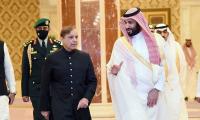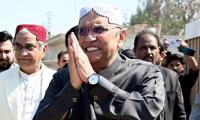India and Pakistan’s warmongering frenzy threatens the existence of more than a billion people. Wars are not rational choices to attain peace, in particular when two nuclear powers opt for the age-old strategy of power realism and Machiavellian tactics of supremacy.
The only beneficiaries of this warmongering across the divide are those who strive to gain public legitimacy through xenophobia and concocted political narratives of exotic threats. These hawks deploy belligerent political tactics to attain popular support when they fail to address issues such as underdevelopment, poverty, illiteracy, malnutrition, unemployment and injustice.
Warmongering is the easiest way to divert public attention away from the longstanding issues of governance, accountability and democracy – which are in short supply on both sides of the divide. Pakistan and India have mastered the art of deflating public anger caused by wretchedness by instilling nationalistic jingoism.
For the world’s largest democracy to function, it takes an anti-Pakistan campaign to unite its bourgeoning urban-middle and lower-middle classes, no matter even if it is spearheaded by a lunatic like Narendra Modi-the icon of corporate thuggery and the macho man whose hands are stained with the blood of thousands of Indian ordinary citizens. The hysterical Indian media – sponsored by the corporates – portrays and promotes an anti-Pakistan discourse to represent Modi more than he represents his own people. Those who dare to speak out against the xenophobic mainstream Indian media get marginalised to blasphemous proportions. The political idiosyncrasies of an arrogant Modi are framed in a quintessential Indianism to create a false pride of rising India beneath the ugly truth of corporate greed and unbridled profiteering.
The beneficiaries of ‘Rising India’, ranging from ‘Om physicists’ to media owners, see this carefully branded xenophobia an opportunity to carve out a business niche in a growing consumerist culture. Having said this, it would be simplistic to suggest that this doctrine of brinkmanship and ultra-nationalism of the Modi government will overcome the growing poplar disenchantments including the undercurrents of political centrifugalism in Kashmir and support to the Maoists’ political stance of the anti-corporate India of poor farmers. The unfounded Indian claims of surgical strikes within Pakistani territory were part of an unabated anti-Pakistan campaign of Modi’s political doctrine which created fissures in the civilian-military relationship in India.
In our part of the Subcontinent, the situation is not much different – barring the lack of corporate branding of anti-Indian campaigns; and we are lucky to have a relatively free media and political space to counter the warmongering narrative. However, this space is fast shrinking. The PML-N government has been under tremendous political pressure due to the Panama leaks, and its failure to implement the National Action Plan. The anti-Indian frenzy has given ample opportunity to the ruling party for recouping its fast deteriorating public image.
The government has also seen this as an important opportunity to improve its relationship with the GHQ by supporting the narrative of national security- shrouded in an anti-Indian campaign.
The relationship between the civilian government and military establishment has plummeted in the recent past, and Nawaz Sharif has been rebuked by many for being complacent towards Modi’s anti-Pakistan bellicosity and for striking ostensible trade deals with India. Nawaz Sharif may not afford the gesture of political defiance against the increasing role of the GHQ in key domestic and foreign policy matters. This is because the military has positioned itself better than the civilian government as the saviour of the country’s people against the threats of domestic terrorism as well as the Indian onslaught.
This speaks volumes about the lack of political competence, vision and diplomatic acumen of the current civilian government. It also shows the vulnerability of our democratic system, which can be derailed almost at will, and the lack of statesmanship to assert the political role above short-term publicity stunts.
South Asian democracies have to learn quickly the art of statecraft, assertiveness of political will and formulation of context-specific policies of engagement for regional stability. Pakistan and India can play a pivotal role towards regional stability, prosperity and peace in South Asia by allowing cultural, economic and political interactions across the border. They need to rein in religious and nationalist fundamentalists, national security hawks and other right-wing political elements for the larger good of their people.
The role of our civil society is equally disappointing because it has failed both to cultivate democratic attitudes and to formulate a counter-narrative against the rising jingoism in India and Pakistan. The space for free expression is shrinking. Alternative voices face existential threat and those who dare to speak out for their compatriots – the poor, illiterate, undernourished and the peasants – become the enemies of state.
Eighty percent of the people of India and Pakistan face problems that are common to all of them – lack of food, proper shelter, quality education, health facilities and a decent living – but these democracies have neither policy priority nor any political will to formulate inclusive strategies to address these chronic causes of poverty. What do we do with these democracies if they do not ensure public accountability, inclusive development policy and socioeconomic transformation of the poor?
The rhetoric of democratic transition will not usher in an era of development and prosperity unless we challenge the narratives of bigotry and resist uncalled-for political belligerence and nationalistic chauvinism in India and Pakistan. We do not have too many options left, we hardly have time to be consumed in futile polemics of nationalism and we are at the brink of mutual assured destruction. We must advocate for an increase in people-to-people interaction and build political pressure on our governments to at least enter into détentes and display the spirit for political rapprochement on an immediate basis.
If nothing else, Pakistan and India may start with an approach of antagonistic collaboration which will then open up the possibility of critical debate on key outstanding political and economic issues – including Kashmir and our water distribution disputes. Negotiation on key issues must not be confined to backchannel diplomacy and endless ministerial level talks, but should also be opened to public scrutiny and democratic accountability. Civil society, policy think-tanks, journalists, academics, artists, businessmen and the youth must be allowed to interact across the borders for peace building. The delegates for these confidence-building measures must include representatives from both sides of Kashmir as well as from Gilgit-Baltistan.
First and foremost, civil society and the media have a larger role to play in building public support against political hawks and strengthening the institution of peoples’ representation in both countries. These strong institutions are the only recipe to dislodge those forces that are responsible for escalating intrastate and interstate violence and conflict. The horror show of war between two nuclear powers is nothing less than the extermination of humanity.
The writer is a freelance columnist based in Islamabad.
Email: ahnihal@yahoo.com
Any progressive society or government will uphold security so that people can utilize their full potential
In Pakistan, we have witnessed erosion of public trust in government institutions
Capability, accountability, and responsiveness don’t quite capture the increasingly important issue of legitimacy
The government can directly influence economic activity through current and capital expenditure
A view of the Supreme Court of Pakistan. — Supreme Court website/FileWhat kind of firewall does the judiciary...
Indian soldiers stand alongside a barbed wire on the Line of Control. — AFP/FileAnti-Pakistan propaganda remains a...







